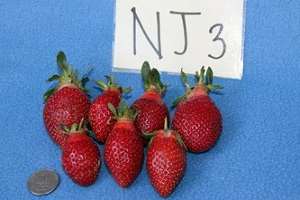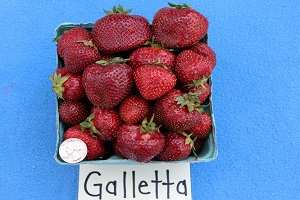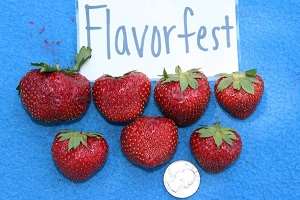We collected data on performance of strawberry cultivars in the second harvest year of a plasticulture planting at the Penn State SE Ag Research and Extension Center in Manheim, (SE) PA.

Back in December 2016, Kathy Demchak reported on a matted-row strawberry variety trial at the Penn State Horticulture Research Farm at Rock Springs. This is a report on the performance of many of these same varieties.
The planting was established in August 2014 and the first harvest was in 2015. Following harvest half of the plants were thinned by removing approximately 50% of the crown by hand. The purpose was to determine whether there is a benefit to this practice when carrying over plasticulture plantings for a second harvest year.
The 2016 season was generally wet the entire harvest period (total rainfall 4.1 inches in 5 weeks) which necessitated use of a standard fungicide program. In addition, the temperatures were well above normal with 15 consecutive days of 80º+ starting the second week of harvest and two 90º+ days in the last week of harvest. There were also some early flower losses because of the weather. High temperatures of 79º and 78º on April 1 and 2 were followed by low temperatures of 18º and 22º on April 6 and 10. Even under two rowcovers on these cold nights the most developed king blossoms were killed on the earliest varieties, particularly ‘Sweet Charlie’.
Harvest started on May 13 with ‘Chandler’ and one of the Rutgers selections; ‘Sweet Charlie’, ‘Daroyal’ and a second Rutgers selection started on May 16; ‘Earliglow’, and ‘Radiance’ started May 18; ‘Galletta’ May 20; ‘Rubicon’, ‘Wendy’, two Cornell selections and the last Rutgers selection on May 23; ‘Donna’, ‘Flavorfest’, and ‘Sonata’ on May 25 and on May 27 the final Cornell selection started harvest.
The thinning treatment generally affected yield and the percentage of marketable fruit, but had no effect on berry size or brix (soluble solids) levels. Thus data presented below for yields and percentage marketable fruit are given for unthinned and thinned treatments respectively, but are averaged over thinning treatment for berry size and soluble solids.
Cultivars
'Chandler'
‘Chandler’ performed about average this season with total yields of 12,230 and 9,611 lbs/acre in the non-thinned and thinned plots, respectively. The marketable percentages were 67 and 72%. ‘Chandler’ had one of the highest plant losses in the planting. A sample was sent to the Penn State Plant Disease Lab and showed Phytophthora rot on this variety. Average size of the marketable fruit was 12.9 g/berry with an average brix reading of 6.6. Overall performance of ‘Chandler’ in this study was not consistent with its position as the standard variety for plasticulture production in the southeast part of PA. It did perform better than in 2015 with yields almost twice as high this season in the unthinned plot.
‘Sweet Charlie’
‘Sweet Charlie’ yields were poor whether plants were non-thinned or thinned (8,139 and 7,366 lbs/acre, respectively) with marketable fruit percentages of 79 and 77% and average berry size of 12.1 g. As noted earlier, many early flowers were lost in the April sub-freezing temperatures. However, these yields were almost 50% better than in 2015 even with the early fruit loss.
‘Daroyal’
‘Daroyal’ had good yields in the unthinned treatment (18,327 lbs/acre) but markedly lower yields when thinned (9,491 lbs/acre). The low yield in the thinned plots might be an artifact of plant population in that part of the field. Average marketable percentage increased from 56% to 73% with thinning and average fruit size was 12.0 g with a brix reading of 6.7. Flavor and appearance were good in both seasons and yields were up about 33% in the unthinned plots compared to 2015.
‘Radiance’
‘Radiance’ had total yields of 13,458 lbs/acre unthinned and 12,334 lbs/acre thinnned with marketable fruit percentages of 62 and 59%. These yields are almost twice what we harvested last season. Average berry size was 15.1 g/berry, brix level was 5.3 and while appearance was excellent, flavor was poor - just as in 2015.
‘Earliglow’
‘Earliglow’ had marketable percentages of 77 and 81% on yields of 11,567 and 11,699 lbs/acre. Flavor was excellent with an average brix of 7.9. Average size was 10.5 g/berry and could look higher than average because we discarded any fruit weighing less than 9.0 g. Earliglow performed similarly in both seasons.
‘Galletta’
‘Galletta’ had very good yields (17,669 and 15,457 lbs/acre) and average fruit size (16.1 g/berry). Brix was 6.8 and 67% of the yield was marketable whether thinned or not. Powdery mildew was again present on this variety. Yields were up 50% compared to 2015 and fruit had the same good size and flavor.

‘AC Wendy’
‘AC Wendy’ was the 2nd highest yielding of the named varieties (18,891 and 17,665 lbs/acre) with marketable yields of 55 and 68%, an average brix of 5.9 and average berry size of 12.9 g. Flavor was poor; heat may have negatively affected the flavor of this cultivar more than most perhaps given its cool-climate origin (Nova Scotia). Performance was similar to 2015 with yields slightly higher in 2016.
‘Rubicon’
‘Rubicon’ had yields of 10,446 and 14,273 lbs/acre, marketable percentages of 58 and 62%, brix of 6.8 and average fruit size of 12.9 g. Berries were very susceptible to softening in the high temperatures we had during harvest. Rubicon performed similarly in both seasons. This was one cultivar that benefitted from crown thinning, presumably because of its noticeably high vigor.
‘Flavorfest’
‘Flavorfest’ was the highest yielding of the named varieties this season with production of 17,977 and 20,599 lbs/A. Average brix was 6.2, marketable percentages were 62 and 59, average berry size was 15.3 g. and flavor and appearance were good. Yields this season were 3 times those in 2015. We are not sure why this occurred – perhaps because we received relatively low-vigor plug plants in 2014, and they needed to have a season to establish, or perhaps this is one variety that can be carried over with good results. This variety may not need to be considered an annual-system-only variety.

‘Sonata’
‘Sonata’ had yields of 13,948 and 17,217 lbs/acre, average berry size of 11.0 g, marketable percentages of 55 and 66% and brix readings averaging 5.3. When averaged, these yields were similar to those in 2015. The fruit had average flavor both seasons. This variety is very vigorous and because of the dense foliage many berries rotted, which likely accounted for the improvement in the percentage of marketable fruit when thinned. In addition, the fruit was also susceptible to softening in the high temperatures during harvest in both seasons.
‘Donna’
‘Donna’ had yields of 13,946 and 12,532 lbs/acre and marketable percentages of 61 and 71%. The fruit had an average brix of 7.6 with good flavor and an average fruit size of 10.9 g. ‘Donna’ was another variety that had high plant losses in this planting. While fruit size was down slightly this season and yields were up slightly, overall performance was similar to 2015.
Cornell selections
The three Cornell selections each suffered from at least one major flaw such as low yields (< 10,000 lbs/acre), low percentage marketable fruit (< 44), high plant losses or poor fruit quality. Two of these selections had higher plant losses in this study as well. These results are consistent with what we saw in 2015 and these selections are not acceptable for growing in the SE part of the state.
Rutgers selections
The three Rutgers selections performed significantly better this year (yields 3-5x those of 2015) – perhaps because they had become better established after our late planting date last year, but yields were still low in two of these selections in the unthinned plots. Yields in the unthinned plots were 9,301, 9,890 and 20,675 lbs/acre and in the thinned plots were 12,456, 12,547 and 16,948 lbs/acre. One selection was the highest yielding cultivar in the trial this year. Brix readings were 8.1, 7.2 and 6.0; average fruit size was 14.1, 12.7 and 15.5 g and marketable percentages were between 58 and 78%. One general trait of all of these selections is excellent flavor. We understand that two of these selections are being considered for commercial release. We understand that Rutgers 'Scarlet,' a recently released variety from the New Jersey program, has similar flavor attributes. We did not test this variety but a grower interested in looking at the New Jersey plant material might consider a trial planting of this named variety.
Source: psu.edu